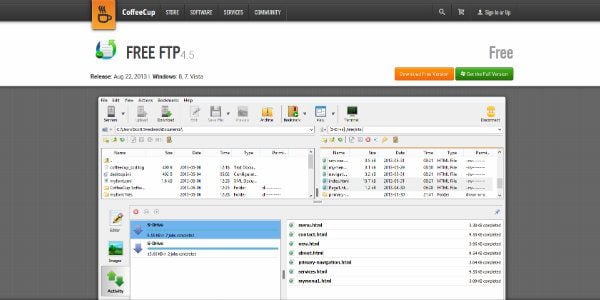Standalone Ftp Client No Install Cell
May 22, 2015. Open source freeware SFTP, SCP and FTP client for Windows. Aug 14, 2008. The computer I had access to had no FTP client (I couldn't install one/didn't want to take the time). My two options were to wait till I got home to. More like a traditional FTP client. It has the classic two column view (the online files on the right and the offline files on the left) with the upload / download arrows.

Advertisement FTP has fallen by the wayside as a file sharing method, but it’s still useful for PC-to-PC and PC-to-mobile transfers, and still the go-to method for. A good FTP experience comes down to the FTP client app you use, so make sure you’re using an FTP client you like. Before you dive into these third-party apps, you should know that you can. This lets you browse FTP servers as if they were attached drives to your system. But if you prefer a dedicated FTP client, keep reading. Here are the best ones you can grab for free — no need to shell out cash for a paid one instead. There is no comparison: WinSCP is the best free FTP client for Windows.

Despite its simple and easy to use nature, it packs a number of advanced features that can satisfy even the most demanding FTP needs. In addition to FTP, WinSCP supports file transferring and remote file editing using SFTP, SCP, and WebDAV protocols. Bosch Serial Number Location Drill there. Regardless of which you use, it can synchronize local directories with remote directories. WinSCP integrates directly into Windows, allowing for seamless drag-and-drop, extra options in the right-click “Send To” menu, and desktop shortcuts to oft-used servers. It also has a built-in text editor that enables immediate editing of remote files (useful for tweaking HTML, CSS, JS, etc.). For power users, WinSCP has a command line interface () and scripting support (batch files and.NET assemblies).
There’s a bit of a learning curve, but it’s great for task automation. And it’s open source! WinSCP is a prime example that, and that it’s possible to.
Cyberduck is a simple but effective FTP client, best suited for the occasional need to transfer files. It isn’t bare-bones by any stretch, and it can certainly be useful for power users, but the interface is simplified. Heavy and frequent file transfers may be easier with a fuller interface. This client is free and open source. It supports multiple protocols on top of FTP, including SFTP and WebDAV, plus easy connections to Dropbox, Google Drive, Google Cloud Storage, Amazon S3, among others.
Cyberduck seamlessly integrates with any external text editor, which is convenient for remote editing of web files. It also has a Quick Look feature that lets you preview files without downloading them. Local directories can be synchronized with remote directories. But Cyberduck’s best feature is its commitment to security.
It comes with a feature called Cryptomator, which encrypts file and directory names and smudges directory structures. In other words, even if someone intercepts your transfer, they can’t see what you’re transferring. The only downside to Cyberduck is the donation prompt. You can hide it, but it reappears every time you upgrade to a new version (between once every few days or every few weeks). It goes away for good if you donate and register — a minor inconvenience for an otherwise great app.
Oxford Handbook Of Ent And Head And Neck Surgery Pdf Books on this page. On Windows, Cyberduck is available as a standalone desktop app and a UWP app from the Windows Store. We recommend the desktop version. Our recommendation of FileZilla comes with a warning.
In 2014, it came to light that a fake version of FileZilla (versions 3.5.3 and 3.7.3) was making its way around the internet. The FileZilla “evil twin” was altered to steal FTP login credentials and store on a remote server. FileZilla also pushes downloads through SourceForge, which fell under scrutiny after it was. While there are, we recommend staying away from SourceForge.
Once shady, always shady. And lastly, FileZilla has long been criticized for storing saved FTP login credentials in plain text.
FileZilla finally added an encrypted master password feature in 2017 (version 3.26.0), but it took over a decade of user complaints before they acted on it. All that being said, FileZilla is a solid FTP client. FileZilla is both and supports file transfers in FTP, SFTP, and FTPS protocols. File transfers can be paused and resumed, connections support both, and it can synchronize local directories with remote directories. Notable features include directory comparison (see which files are new or missing), custom directory listing filters (create your own filter conditions), remote file search (with flexible filters and pattern matching), and bookmarks for easy access to frequently used directories.
An Important Note on FTP vs. SFTP One of the biggest flaws of FTP is that it’s a plain text protocol, which means data is sent back and forth in human-readable text. This is a huge vulnerability because login credentials are also sent in plain text! If someone intercepts a login attempt, it’s trivial to see the account’s username and password, let alone the contents of transferred files. Which is why you should prefer SFTP over FTP whenever possible. SFTP, which stands for Secure File Transfer Protocol, uses encryption to protect the data being transferred (both login credentials and file contents).
Learn more about. The good news? Most services that allow FTP connections also support SFTP connections. And when using an FTP client, the actual workflow is the exact same between FTP and SFTP.
The only difference is that you choose SFTP instead of FTP when connecting. Which FTP client will you be choosing? Are there any other good ones that we missed? Or do you prefer another file transfer protocol altogether?
Let us know in the comments below! Image Credit: chrupka via Shutterstock.com.